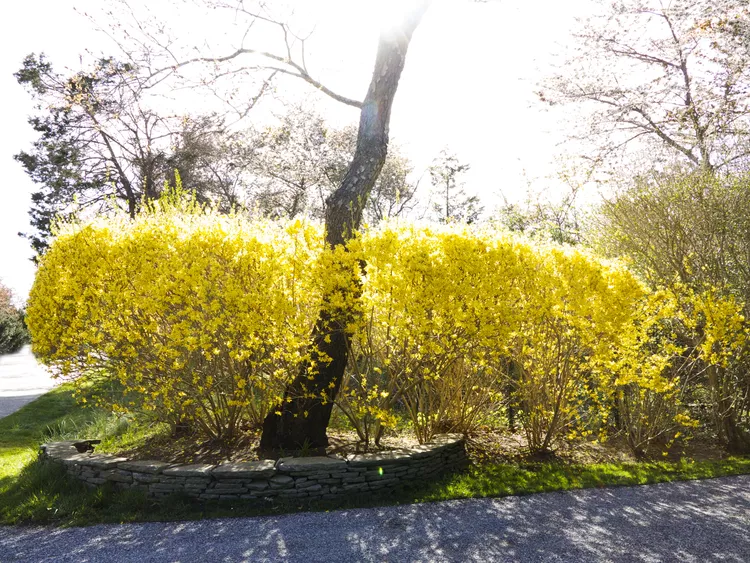Knowing how and when to prune forsythia is critical for keeping this shrub healthy and its spring blooms bountiful. It's among the first shrubs to bloom in landscapes as winter begins to fade. The warm yellow flowers in cold, gray gardens are a reassuring sign that spring is near. But pruning at the wrong time could result in no flowers. Though this low-maintenance shrub doesn't need much from you after it's established in your landscape, these must-know pruning tips will help you enjoy plenty of flowers from your forsythia.
Why You Need to Prune Forsythia
Forsythia has a graceful, airy shape, but when left unpruned, this shrub can turn into a dense, unruly tangle of old branches that don’t bloom much. You'll have a bunch of sticks and leaves and only a few flowers. Pruning encourages the forsythia to grow new branches that bloom profusely.
Regular pruning of forsythia is also important for disease management. Increasing the airflow around the plant and exposing its branches to more sunlight reduces several plant diseases that can afflict forsythia.
When to Prune Forsythia
Timing is key when pruning forsythia.
Cut back forsythia in mid-spring, after it blooms. Forsythia flowers appear from February to April, so you must prune the shrub no later than mid-June. Forsythia produces next year’s blooms on the previous year’s stems. If you cut off those stems in the summer or fall, you cut off next year’s flowering branches, and you’ll have a flowerless forsythia the following spring.
Wait until new leaves show up before you prune. Forsythia flowers emerge before the leaves. So, the blooms are on bare branches. Don’t prune the forsythia until the flowers have faded and new leaves have appeared on the branches. If you prune before leaves appear, you can damage the plant.
Types of Pruning
There are two types of forsythia pruning. The pruning you do depends on the age and condition of the plant.
Maintenance Pruning
Maintenance pruning is a light trim done on forsythia annually to keep the shrub in shape and blooming. This is when you remove dead wood and suckers, deadhead the flowers, trim the tips on blooming stems, and lop off the one or two largest branches. Do this type of pruning in the spring after the plant has flowered.
Rejuvenation Pruning
Rejuvenation pruning is a heavy pruning done on older shrubs that are leggy and overgrown. Rejuvenation pruning, also called hard pruning, can revive an old, overgrown forsythia that has been neglected. A rejuvenation prune involves cutting down a third of the shrub’s height to force it into a new cycle of growth.
Do a rejuvenation pruning on forsythia when the plant is dormant. If you do a hard prune in the spring, forsythia branches bleed sap, which weakens it.
A rejuvenation pruning interrupts the bloom cycle, which means you won’t get flowers in the spring, but it’s a short-term sacrifice for the long-term health of the plant. If you cannot bear the thought of a spring with no forsythia flowers but your shrub desperately needs a hard prune, cut back half of the shrub one year and the other half the following year. That way, you get a half shrub’s worth of forsythia and a half shrub’s worth of rejuvenating leaves and stems.
Tips for Pruning Forsythia
- Remove Large Branches: Use long-handled garden loppers to prune one or two of the largest branches in a forsythia bush each year. This allows sunlight and air into the center of the shrub, keeping it healthier and less likely to get fungal diseases.
- Remove Damaged and Weak Wood: Look for small stems and branches that are damaged, weak, diseased, or dead. Use a pair of sharp hand pruners to remove them.
- Cut Back Stems That Just Flowered: With your hand pruners, cut off stems that just bloomed by one-half to encourage strong new growth for the rest of the season.
- Remove Suckers: Suckers are new plant shoots that grow from the base of the forsythia shrub. Over time, they crowd out the main stems and make the shrub look messy and shapeless. Cut the suckers off at the ground so the forsythia’s energy goes into growing leaves and flowers on its main stems.




















